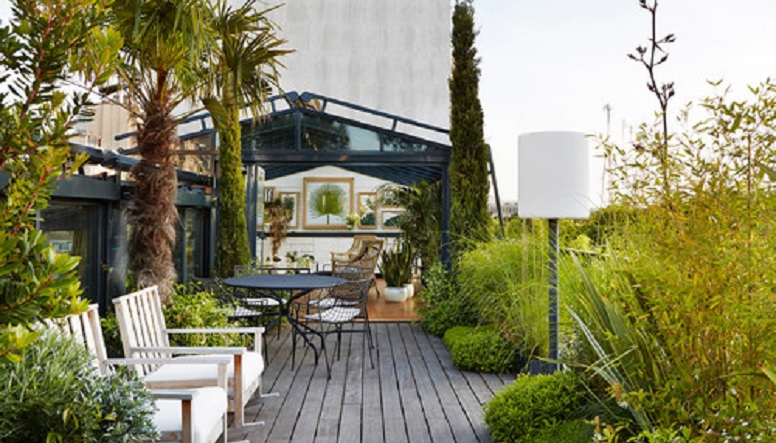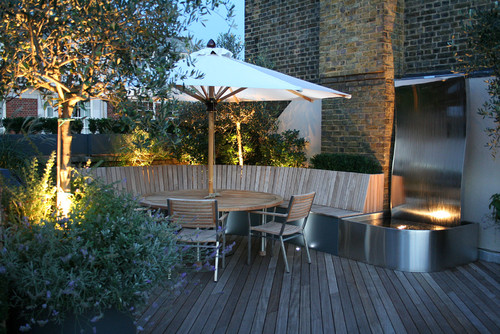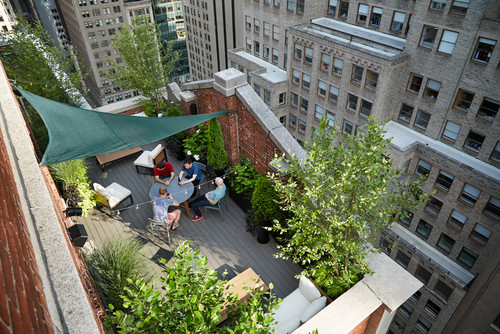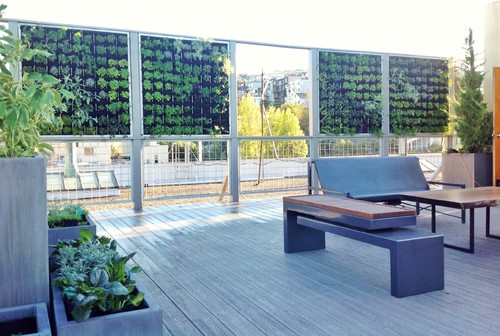PLANT MISERY? RESCUE GUIDE FOR PLANT AND FLOWER HELP
Prescriptions for plant protection
For trusted expertise and superior results,
find a landscape professional near you.

Presented by the National Association of Landscape Professionals in partnership with 
By Lauren Dunec Hoang
With a few clever strategies, such as expanding planting, screening adjacent buildings and maximizing outdoor living space, rooftop terraces can feel larger and more secluded than they really are. Let’s take a look at rooftop gardens, perched in cities from San Francisco to Paris, that offer design ideas to make the most of an elevated urban terrace.

1. Treat your rooftop like an outdoor living room. This stylish indoor-outdoor Parisian rooftop terrace has all the trappings and comforts of a living room inside the house, such as cushy furniture, wall art and lighting. For your own terrace, try seeing the space as though it were a room inside, and imagine how you would arrange it — likely more lavishly than a room outdoors.
While not all decor makes sense outside, investing in comfortable outdoor furniture and adding details such as an outdoor rug, potted plants, a shade structure or umbrella, and lighting will make the space all the more inviting.

2. Grow a green screen. To make your rooftop feel more like a secluded garden retreat and less like a fishbowl, invest in screens, fences and planters, and grow vines and shrubs to block views of adjacent buildings. In this London terrace the designer used a wooden lattice fence to provide support for a leafy screen of confederate jasmine (Trachelospermum jasminoides; USDA Zone 8; find your zone), screening nearby buildings and perfuming the terrace with a citrusy-sweet fragrance.
Go a step further and cover an area of the rooftop with a pergola or shade sail. You’ll benefit from both the shade and the added sense of privacy from neighbors’ windows.
3. Add softness. Make a rooftop of any size seem more inviting by arranging a scattering of brightly colored weatherproof pillows and laying down outdoor rugs to soften the floor. The informal setup would encourage you and your family or friends to use the terrace as a summer hangout.

4. Carve out curves. Adding curves can help tone down the feeling of being surrounded by hard-edged man-made structures and make a rooftop terrace feel more like a garden. In this rooftop in London’s Marylebone area, for example, the designer created curves through multiple methods. A custom curved bench snakes around a round outdoor table, forming an inviting seating area and defining the edge of the planting bed. The metal fountain is also in a loose S-curve shape rather than a more common vertical plane. While not a curve, per se, the decking set at a diagonal also visually breaks up the boxy space formed by the surrounding buildings.
Growing tips: Set your plants about 1½ feet apart in the garden or add them to containers after the hot weather cools; lightly fertilize throughout the garden season. If you're planting them in the garden, choose a new spot each year, as soil diseases can be a problem. As a plus, while these are “flowering” varieties, their leaves are edible.
5. Set plants up for success. Lush vines, leafy shrubs, swaying grasses and colorful flowers all help transform an urban terrace into a calming oasis. For plants to thrive on a rooftop terrace, they’ll need the right light exposure and adequate soil and water. Invest in built-in planters or medium to large containers that won’t dry out quickly. Ideally, hook up a drip irrigation system.
Vines and tall, skinny plants, such as arborvitae, and large ornamental grasses (pictured in this Manhattan rooftop) offer a good bang for your buck in terms of providing lots of green while only taking up a little floor space.

City terrace gardens often have an “urban canyon” light exposure, where plants are either in the deep shade cast by buildings or in full, blaring sun. Hanging a shade sail that still allows light to penetrate, like this one partially covering the Manhattan rooftop garden, creates a more consistent growing environment for plants and a more comfortably shaded hangout spot for people.

6. Make room for your top priorities. Whether your main objective is creating a spot for outdoor entertaining or a tranquil, private retreat (or both), design your rooftop terrace to support how you’d like to use the space.
This playful rooftop in Paris, for example, includes a couple of distinct seating areas, each with a different intended use. A lounge chair on the upper level would be a great spot for solo relaxing, while a trio of chairs could be used to host a small group.

7. Bring a bit of wildness. Welcome native birds, bees and butterflies to your rooftop by hanging a feeder, adding a water source and choosing plants that provide food or nest-building materials.
In contrast to the concrete landscape of the city, one could imagine this Chicago rooftop would look like an oasis to our feathered friends and beneficial insects. The rooftop includes a fresh water source and deep plantings of pollinator and seed-eater favorites, including black-eyed Susan (Rudbeckia sp.), purple coneflower (Echinacea purpurea, zones 3 to 9), ‘Autumn Joy’ stonecrop (Sedum ‘Autumn Joy’, zones 3 to 10), lavender and salvia.

8. Go vertical. Take advantage of the walls bordering a rooftop terrace to provide support for vines or offer a backdrop for outdoor wall art.
This London rooftop makes use of a brick wall for mounting an Asian-style wood screen and a set of carved wooden doors, as well as a wire trellis for a rambling confederate jasmine (Trachelospermum jasminoides; USDA Zone 8) vine. The vertical features add depth to the terrace without taking up any floor space.

Conversely, install a living wall for vertical interest and expanded planting space. For example, this rooftop garden atop Anchor Distillery in San Francisco features four vertical panels planted with strawberries, basil, lavender, rosemary and scented geraniums.

9. Create evening ambiance. Extend the hours of enjoyment of your rooftop terrace by installing outdoor landscape lighting or simply hanging a few crisscrossing strands of cafe lights. This city roof terrace in Chicago makes use of a combination of lights on the birch trees to provide soft washes of light and downcast spotlights beneath the cedar pergola to illuminate the seating areas.
More from Houzz
Pretty Patio Umbrellas in Every Color
We recently updated our Privacy Policy. By continuing to use this website, you acknowledge that our revised Privacy Policy applies.